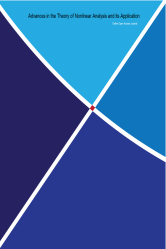Modified Quasi Boundary Value method for inverse source biparabolic
Modified Quasi Boundary Value method for inverse source biparabolic
Inverse source biparabolic, Ill-posed problem, Regularization,
___
- [1] V.M. Bulavatsky, Biparabolic mathematical model of the filtration consolidation problem, Dopov. NAN Ukrainy, No.8, 13–17 (1997).
- [2] V.M. Bulavatsky, Mathematical modeling of filtrational consolidation of soil under motion of saline solutions on the basis of biparabolic model, J. Autom. Inform. Sci., 35, No.8, 13–22 (2003).
- [3] V.M. Bulavatsky and V.V. Skopetsky, Generalized mathematical model of the dynamics of consolidation processes with relaxation, Cybern. Syst. Analysis, 44, No.5, 646–654 (2008).
- [4] J. Hadamard, Lectures on the Cauchy Problem in Linear Differential Equations, Yale University Press, New Haven, CT, 1923.
- [5] K.A. Ames, B. Straughan, Non-Standard and Improperly Posed Problems, Academic Press, New York (1997).
- [6] A.S. Carasso, Bochner Subordination logarithmic diffusion equations, and blind deconvolution of Hubble space telescope imagery and other scientific data, SIAM J. Imaging Sci. 3(4), 954–980 (2010).
- [7] L.E. Payne, On a proposed model for heat conduction, IMA J. Appl. Math. 71, 590-599 (2006).
- [8] L. Wang, X. Zhou, X. Wei, Heat Conduction: Mathematical Models and Analytical Solutions, Springer, Berlin (2008).
- [9] Huy Tuan Nguyen, Mokhtar Kirane, Nam Danh Hua Quoc and Van Au Vo, Approximation of an Inverse Initial Problem for a Biparabolic Equation, Mediterranean Journal of Mathematics (2018) 15:18, https://doi.org/10.1007/s00009-017-1053-0.
- [10] Danh Hua Quoc Nam, Le Dinh Long, Donal ORegand, Tran Bao Ngoc and Nguyen Huy Tuan, Identification of the right- hand side in a bi-parabolic equation with final data, Applicable Analysis https://doi.org/10.1080/00036811.2020.1775817
- [11] R.E. Showalter, The final value problem for evolution equations, J.Math.Anal.Appl., 1974, 47, 563-572.
- [12] R.E. Showalter, Quasi-reversibility of first and second order parabolic evolution equations, Improperly Posed Boundary Value Problems. Pitman, London, 1975, 76–84.
- [13] N. Boussetila, F. Rebbani, Optimal regularization method for ill-posed Cauchy problems, Electron. J. Differential Equa- tions, 2006, 147, 1-15.
- [14] Nguyen Huy Tuan, Tran Ngoc Thach, Hoan Luu Vu Cam and Nguyen Huu Can, On a final value problem for a biparabolic equation with statistical discrete data, Applicable Analysis, DOI: 10.1080/00036811.2020.1723554.
- [15] K. Besma, B. Nadjib, and R. Faouzia, A modified quasi-boundary value method for an abstract ill-posed biparabolic problem, Open Mathematics, Research Article, https://doi.org/10.1515/math-2017-0140.
- [16] A. Lakadari, N. Boussetila, An iterative regularization method for an abstract ill-posed biparabolic problem, Boundary Value Problem, 2015, 55, 1-17, https://10.1186/s13661-015-0318-4.
- [17] F. Zouyed, S. Djemoui, An Iterative Regularization Method for Identifying the Source Term in a Second Order Differential Equation, Hindawi Publishing Corporation, Mathematical Problems in Engineering, Volume 2015, 9 pages.
- [18] Z. Chen, Y. Lu, Y. Xu, H. Yang, Multi-parameter Tikhonov regularization for linear ill-posed operator equations, J. Comput. Math., 2008, 26, 37 – 55.
- [19] R. Courant, D. Hilbert, Methods of mathematical physics. New York (NY): Interscience; 1953.
- [20] M.T. Nair, S.V. Pereverzev, U. Tautenhahn, URegularization in Hilbert scales under general smoothing conditions, Inverse Prob. 21(6) (2005), 1851-1869.
- [21] V.M. Bulavatsky, Fractional differential analog of biparabolic evolution equation and some its applications, Cybernetics and Systems Analysis, 2016, 52(5), 337–347.
- [22] L. Joseph, D.D. Preziosi, Heat Waves, Rev.Mod. Physics, 1989, 41–73.
- [23] D. Coltony, M. Pianayand, R. Potthast, A simple method using Morozovs discrepancy principle for solving inverse scattering problems, Inverse Problems, 13 (1997), 1477 – 1493.
- [24] Said Abbas, Mouffak Benchohra, Johnny Henderson and Jamal E. Lazreg, Weak Solutions for a Coupled System of Partial Pettis Hadamard Fractional Integral Equations, Advances in the Theory of Nonlinear Analysis and its Applications Volume 1, Issue 2, Pages:136-146, Year: 2017, Article Id: 2017:9
- [25] Samira Hamani, Wafaa Benhamida, Johnny Henderson, Boundary Value Problems For Caputo-Hadamard Fractional Dif- ferential Equations, Advances in the Theory of Nonlinear Analysis and its Applications Volume 2, Issue 3, Pages:138-145, Year: 2018, Article Id: 2018:13
- Başlangıç: 2017
- Yayıncı: Erdal KARAPINAR
Set inner amenability for semigroups
Determinantal forms and recursive relations of the Delannoy two-functional sequence
Feng Qİ, Muhammet Cihat DAĞLI, Wei-shih DU
Review of the convex contractions of Istratescu's type in various generalized metric spaces
Milanka GARDASEVİC-FİLİPOVİC, Katarina KUKİC, Zoran MİTROVİC, Stojan RADENOVİC
Modified Quasi Boundary Value method for inverse source biparabolic
Nguyen Duc PHUONG, Nguyen LUC, Le Dinh LONG
On a final value problem for parabolic equation on the sphere with linear and nonlinear source
Nguyen Duc PHUONG, Tran BİNH, Nguyen LUC
Monotone Iterative Technique for Nonlinear Periodic Time Fractional Parabolic Problems
Abdelilah LAMRANI ALAOUI, Elhoussine AZROUL, Abdelouahed ALLA HAMOU
